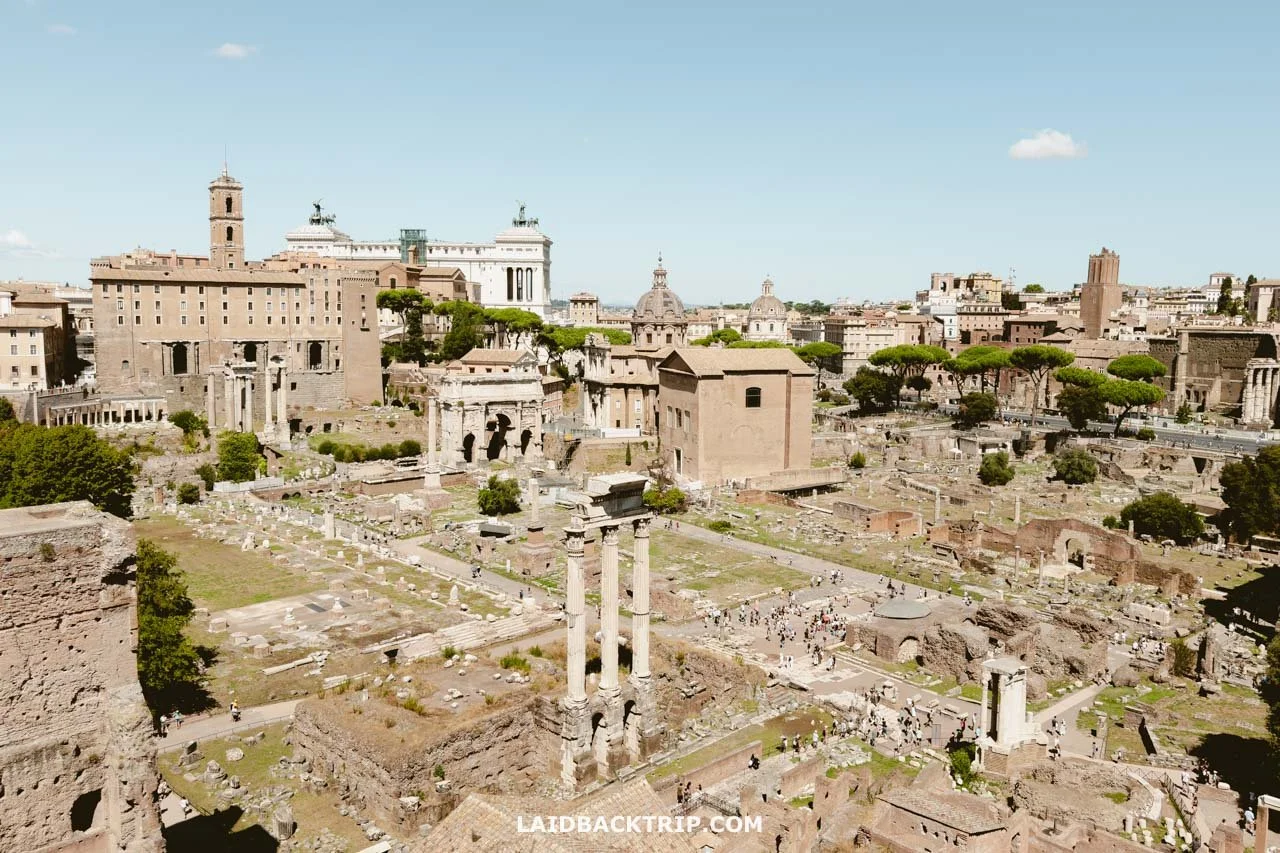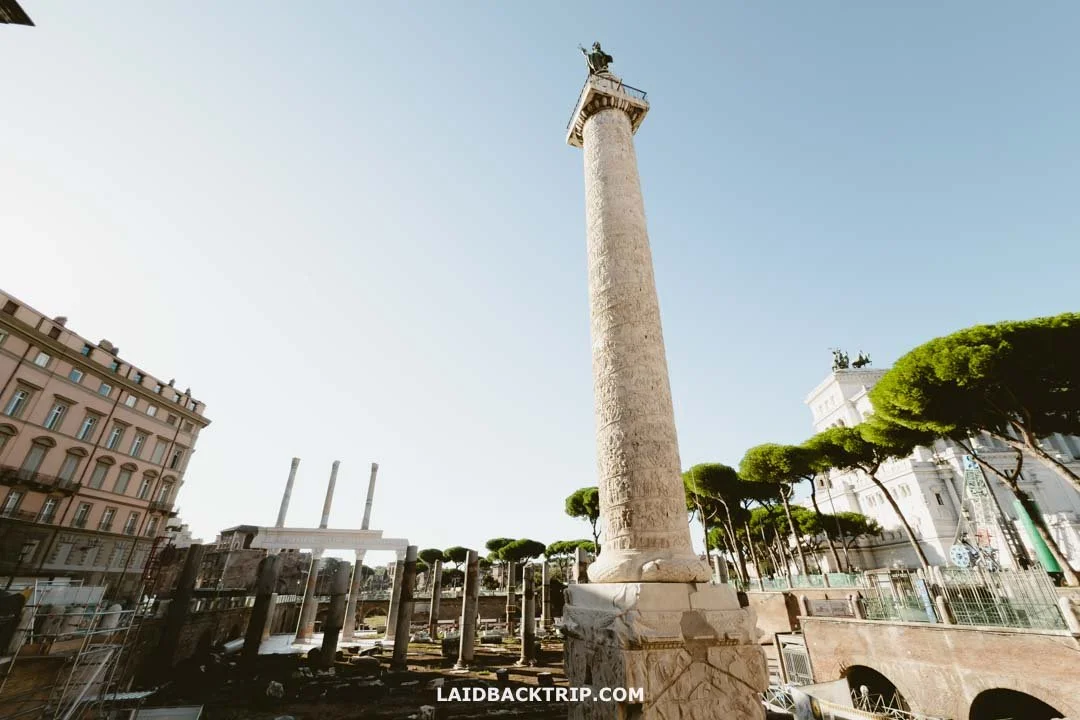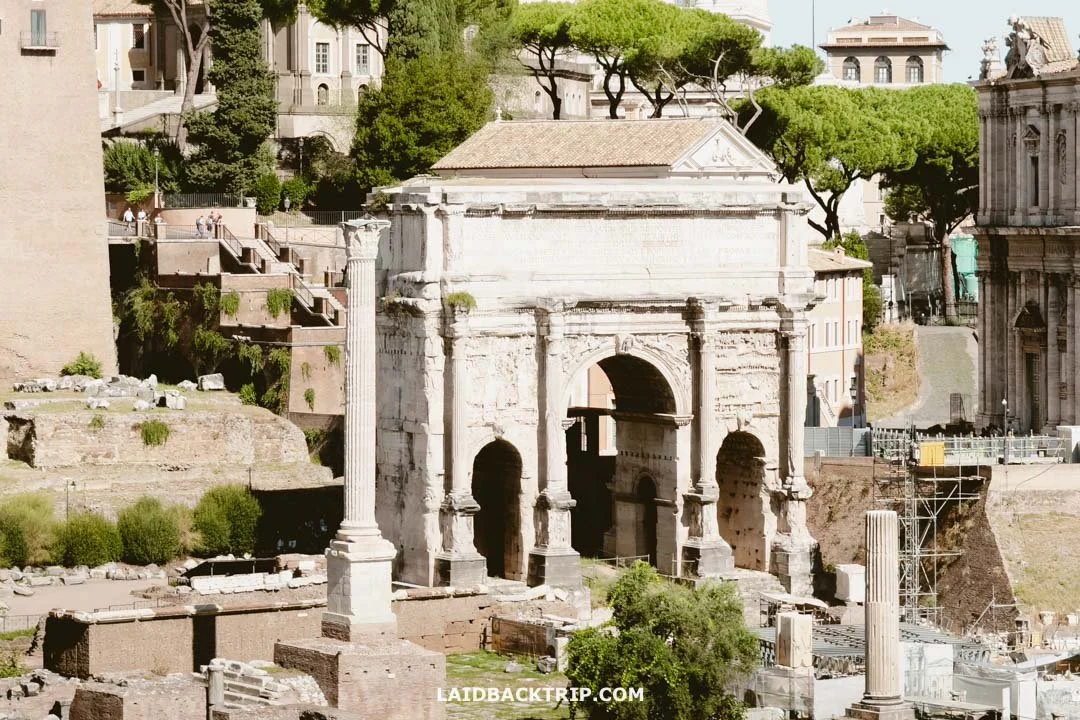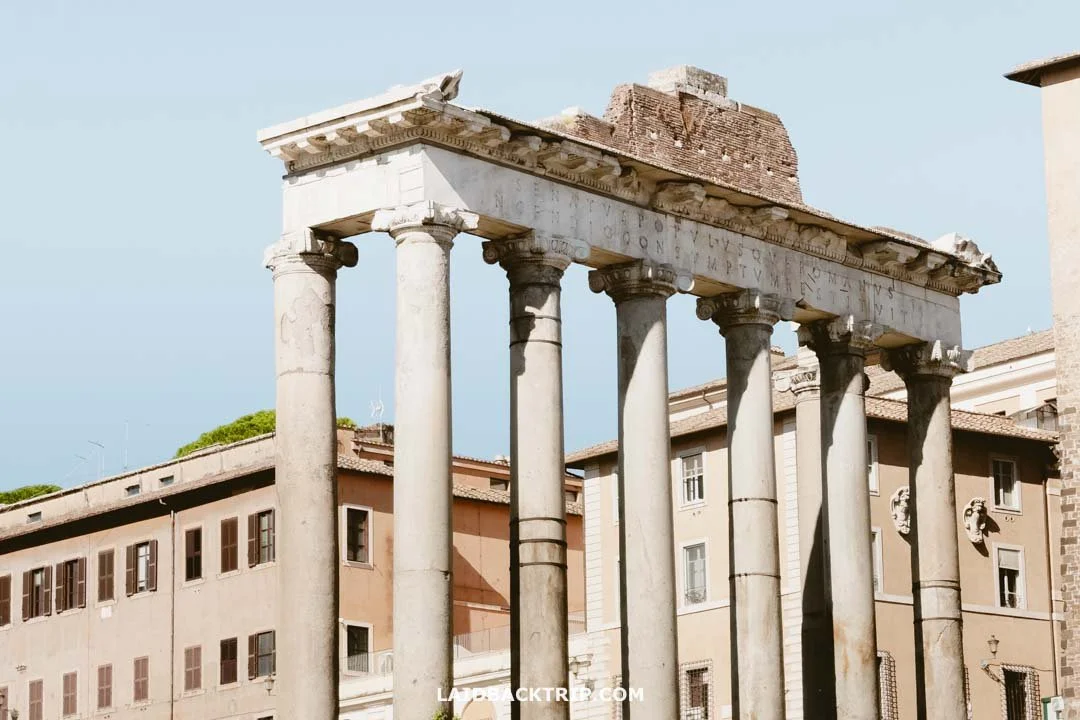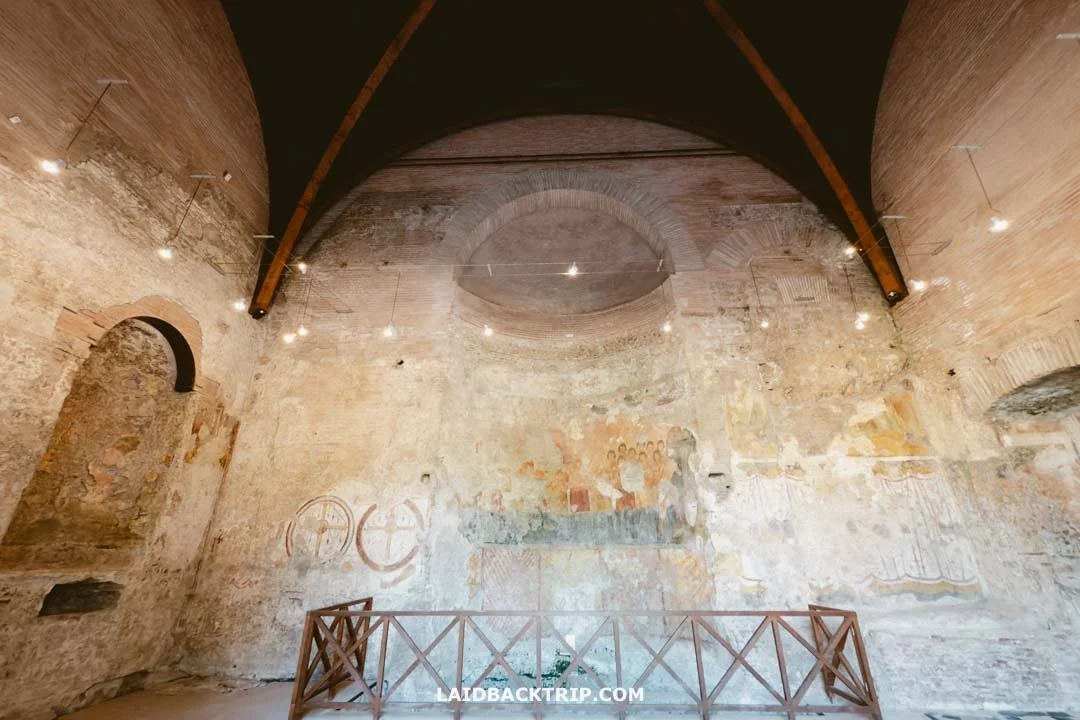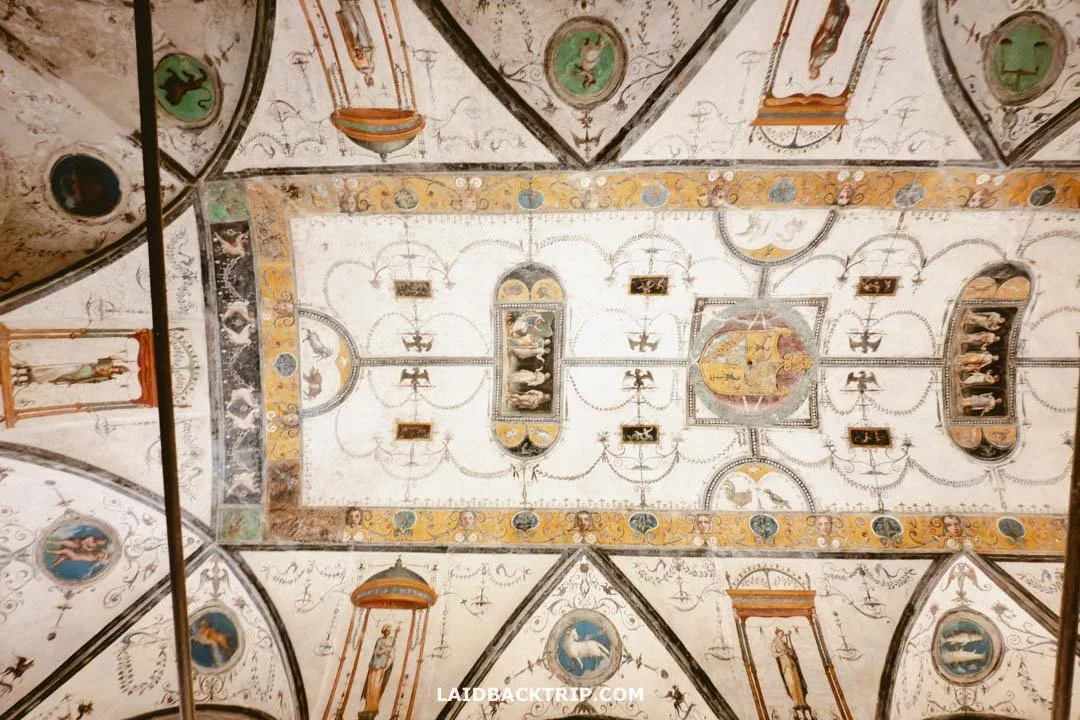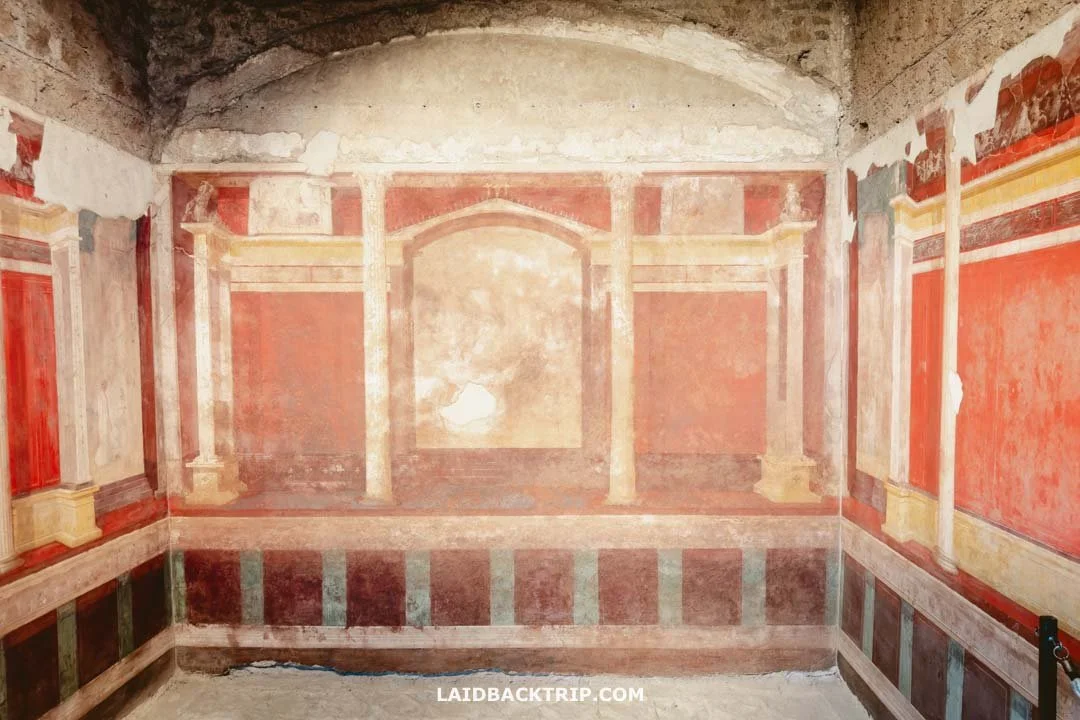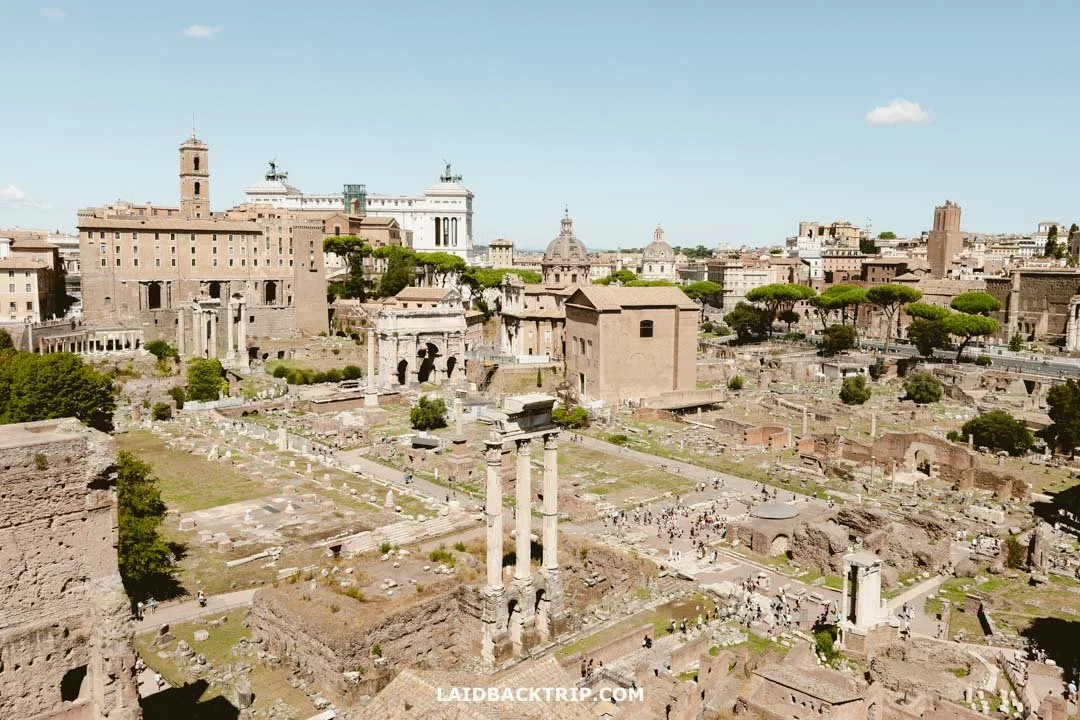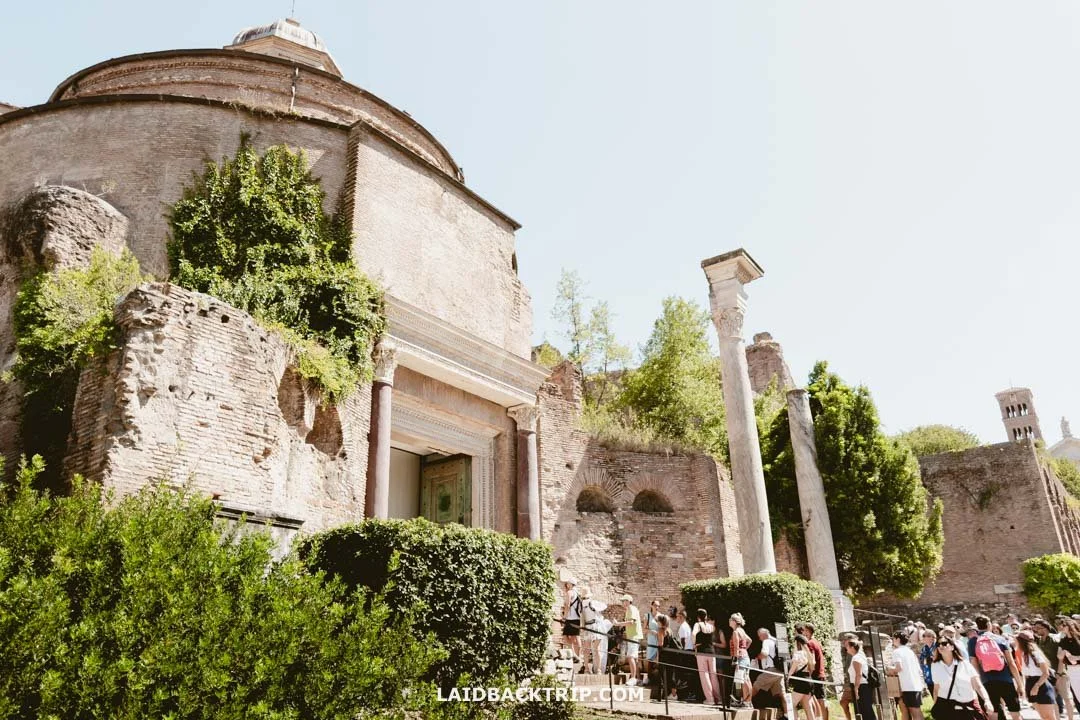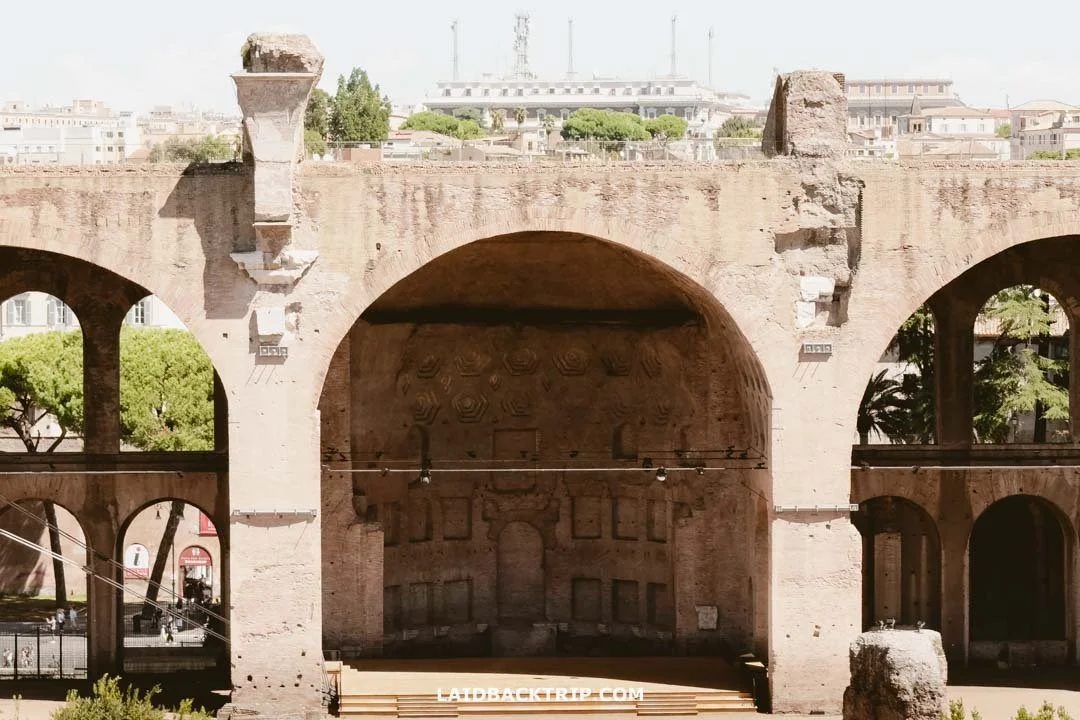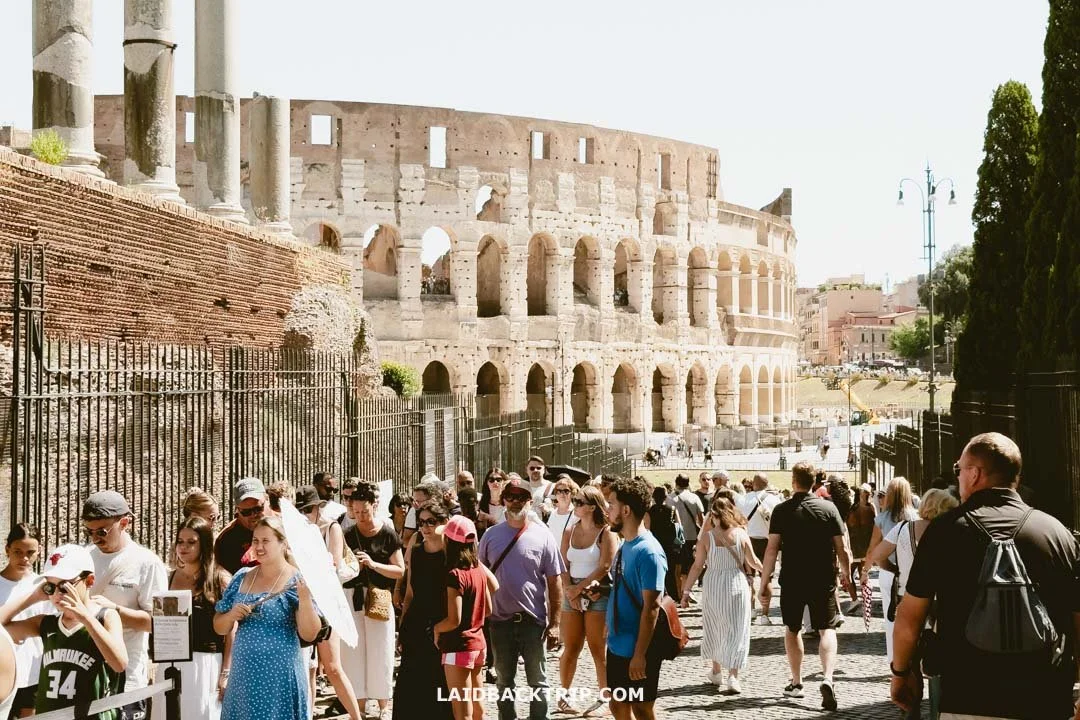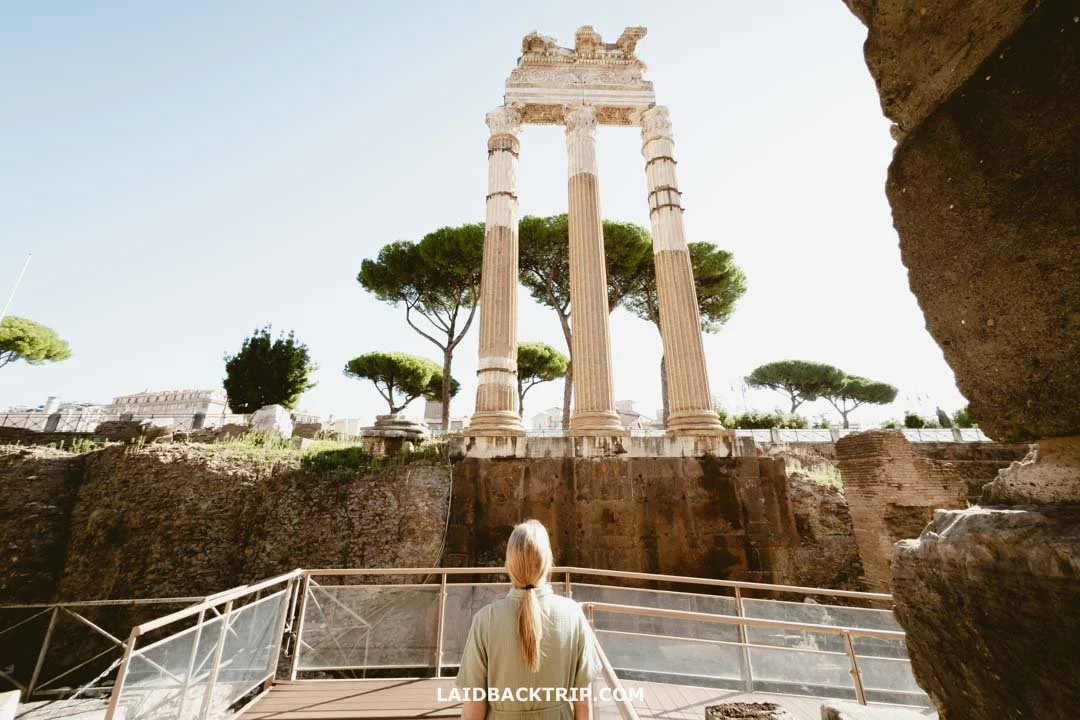Our First Visit to the Roman Forum and Palatine Hill
The Roman Forum served as the ancient center of Rome, once filled with temples, markets, and politics.
This is a guide on how Lucie and I visited Roman Forum for the first time.
Since the Roman Forum (or Forum Romanum in Latin), which also included the Palatine Hill and Imperial Forum, was one of Rome's top attractions, it was only a matter of time before we went to see it. We were on our first trip together to Italy's capital, and this was one of those sites we just couldn't miss. This was the place where Rome was founded and where the mighty Roman Empire began, where Julius Caesar, Augustus, or Romulus once walked. For any first-time visitor, this was a must-see.
I actually visited the Roman Forum about 25 years ago, but I have to admit that after such a long time, my memories of it were pretty hazy. So I was really excited, since after all that time, it felt like a completely new experience. It wasn't just my memory that had faded, though. The entire complex had changed a lot. Back then, the Imperial Forum wasn't really open, Domus Tiberiana was closed, there were no Super Sites, and the archaeological area didn't even charge an entry fee. But times change.
Since this was once the most important place in ancient Rome (and the world), we planned to see the Roman Forum as soon as possible, so our visit happened on our second day (our first day was arrival, so that doesn't really count). Not only were we curious about the whole site, but we also felt that since this was where ancient history was shaped, there was no better place to start our Rome trip. So we did.
One last thing I want to mention about this guide is that it includes information on all three parts of the complex: the Roman Forum (or even simply the Forum), Palatine Hill, and Imperial Forum. However, I often simplify things and just use the name Roman Forum when talking about general topics like admission or opening hours, simply because it's the most famous part of the complex, and it makes no sense to list all three names every time. So here's how our visit went.
We couldn't wait to explore the Roman Forum, so we got there early in the morning.
What to Expect from the Roman Forum and Palatine Hill
After a few hours of walking around the ruins, Lucie made a really good point about why the Roman Forum, Palatine Hill, and Imperial Forum were actually never overbuilt, which was a great question. We were practically in the middle of Rome, yet there was this huge open area filled with ruins. A quick look back at history showed that there were several reasons for that.
After the decline and fall of the Western Roman Empire in the 5th century, Rome's population dropped from over a million to just a few tens of thousands (a fact that's hard to imagine). People moved to lower-lying areas like the Campus Martius, so there wasn't really any reason to build anything in the old area. In the centuries that followed, the site was used, like so many other Roman ruins, as a source of building materials, meaning that while it was neglected and scavenged, it wasn't untouched.
This is how the Roman Forum looks after two thousand years.
And this brings me to my main thought, which connects to the expectations we had when visiting the Roman Forum. From my earlier visit, I remembered a few basics about its history and that the whole area was full of ancient ruins. Interestingly, I couldn't recall any structure that stuck in my mind like the Pantheon, which I remembered very clearly. That was simply because there wasn't one, as most of the buildings here were really just 'ruins.'
On the surface, the Roman Forum, Palatine Hill, and Imperial Forum are all made up of ruins in all kinds of states. Sometimes we could only the base of a building, sometimes a wall, or a few columns still standing. I recall that even places like Jerash or Caesarea had something that stuck in my mind. But since this was once the center of the empire, we couldn't help expecting something more.
Some of the surviving structures only made it through the centuries because they were later turned into churches, like the Curia Julia (the Roman Senate House) and the Temple of Antoninus and Faustina. As a result, both became the best-preserved buildings in the Roman Forum. The Curia Julia still had mostly intact walls, while the Temple of Antoninus and Faustina kept its impressive columns and porch. Some others were restored and reopened as museums, such as Domus Tiberiana or the Houses of Augustus and Livia. Thankfully, this was one of those sites where the historical significance alone made up for it.
We even visited a couple of museums inside the Roman Forum.
History of the Roman Forum, Imperial Forum, and Palatine Hill
To really get this site, we need to dive a bit into its history. And here, it couldn't be more interesting, though we'll keep it brief. Simply put, the area that includes the Roman Forum, Palatine Hill, and Imperial Fora acted as the political and administrative core of Roman life for more than a thousand years, from the early Republic up to the fall of the Western Roman Empire.
This was the heart of the greatest empire of the ancient world (at least in the West). The Roman Forum area was active from the 7th century BCE until the 5th century CE as the core of Roman authority, which made it one of the longest-lasting in existence. Naturally, history didn't stop there, but the next big chapter began with the excavations of the 19th and 20th centuries and the rise of modern tourism.
It's pretty amazing to think that these ruins were once the heart of the ancient world.
My goal here isn't to tell a thousand years of Roman history, because, well, that's clearly beyond me, not to mention you'll have plenty of chances to learn about it once you're there. But I do want to share one tip that made our visit to the Roman Forum much more enjoyable, and hopefully it will do the same for you.
Before our trip, we brushed up on some of our high school Roman history by skimming through Wikipedia. So when we came across terms like Republic or Fall of Rome, or names like Augustus, Trajan, or Julius Caesar (just to name a few), we didn't have to stop and recall who was who (or whether Trajan lived in the 1st or 2nd century CE). If your knowledge of this period is rusty or minimal, a quick 20-minute history recap will do the trick.
Getting to the Roman Forum's Entrance
The Roman Forum, Imperial Forum, and Palatine Hill all sit side by side within one huge archaeological complex. And since the whole complex is in the heart of the city, it's super easy to reach just by walking. It definitely was for us, as we stayed at the lovely Hotel Navona, roughly one kilometer from the site.
We were about a 10-minute walk from the Roman Forum, so it was super easy to get there.
Piazza Venezia and the Colosseum, which sit next to the site, are both well connected by metro, tram, and bus. However, if you're based in the historic center, walking is almost always the simplest way. The Rome Hop On Hop Off buses also stop several times near the Roman Forum. Once we knew how we'd get there, we just had to decide which entrance we'd use to access the Forum.
Entrance(s) to the Roman Forum
When we looked into the ticket info, we found there were five different entrances to the archaeological site. Two led into the Roman Forum (Via Sacra and Via di San Pietro in Carcere), two into the Imperial Forum (Piazza Venezia and Largo della Salara Vecchia), and one into the Palatine Hill (San Gregorio). We could start anywhere, but since the Imperial Forum entrance at Piazza Venezia was nearest to our hotel, we picked that one because it was the most convenient.
We entered the ancient complex through this gate in the Imperial Forum.
Because the Imperial Forum entrance was closest to where we stayed, and the Colosseum (our next stop) was on the far side of the site, we started with the newest part, the Imperial Forum. Then we made our way through the Roman Forum and saved the oldest section, the Palatine Hill, for the end.
Even though we explored the site in what you could call "reverse historical order," it didn't really matter. Sure, starting with the Palatine Hill might have made more sense, since that's where Rome was founded, but the hill was later covered by the emperors' palaces, which were built much later, making that logic kind of pointless. So in the end, the order didn't matter that much.
Opening Hours of the Roman Forum
The Roman Forum was open from 9:00 AM to 7:15 PM when we visited, which was in early September, still part of the summer season. The complex opens daily at 9 AM throughout the year, but the closing time varies with the seasons. In October, the Roman Forum and Palatine Hill close at 6:30 PM, in March at 5:30 PM, and during the winter months at 4:30 PM.
Roman Forum opening hours change with the season.
Since we didn't want to waste any time waiting in line, we arrived about 15 minutes early. We had decided to enter the complex through the Trajan Forum from Piazza Venezia, right next to the famous Victor Emmanuel II Monument, and expected it to be a popular entry point. But we couldn't have been more wrong. There was no line at all, and from what we saw, hardly anyone else looked like they were planning to enter from there.
With 15 minutes left before the site opened, we didn't just stand around but took the chance to enjoy the first section, the Trajan Forum, from above. It turned out to be a pretty cool experience, as a stone bridge spans this part, allowing visitors to walk around (and across) the entire area. It wouldn't be the last time this section surprised us, though we had to wait until we were inside to see its next trick.
The Super Sites within the Roman Forum had their own hours.
Tickets to the Roman Forum (and Super Sites)
As we made our way down the steps toward the archaeological site and the ticket checkpoint, it was a good time to talk about the general admission to the Roman Forum, since there were six (!) different tickets available. We soon found out that while the Roman Forum and the Colosseum are technically separate, several tickets included both, which wasn't surprising given they're part of the same archaeological park.
Of course, we wanted to visit both, so we immediately ruled out the basic ticket called Forum Pass Super, priced at €18. It offered access to the Super Sites but didn't include the Colosseum. So we checked the other options. Two more €18 tickets existed, though each had a catch. The 24H Colosseum ticket included the Roman Forum but not the Super Sites, and the 24H Only Arena gave access to Super Sites but offered only partial entry to the Colosseum, which wasn't what we wanted.
It was also possible to get tickets on the spot.
So we turned to the three Full Experience tickets for €24, which included everything we wanted (the Colosseum and Super Sites), though with a few caveats. The biggest one, surprisingly, wasn't about the Roman Forum but the Colosseum. Each of the three versions gave access to a special area: the Arena, Underground, or Attic. Unfortunately, the most popular ones, Underground and Attic, were already sold out, so we ended up with the Arena option since we hadn't booked ahead.
There was also the matter of timed entry at the Colosseum, which forced us to cut our visit to the Roman Forum shorter than we wanted, so we could reach the Colosseum entrance at our set time. Honestly, that was also on us for not planning earlier. The bigger issue was that every ticket was single-entry, meaning once we exited the Roman Forum, there was no going back in.
What we really appreciated, though, was how fair the ticket prices were. Both the Roman Forum and the Colosseum are among the most famous landmarks in the world (especially the Colosseum), yet the entry fee felt totally reasonable. Interestingly, a few days later, we took a day trip to Tivoli, where two UNESCO sites, Hadrian's Villa and Villa d'Este, were more expensive. And while we loved both, they definitely didn't carry the same world-famous status.
Can You See the Roman Forum for Free?
Speaking of tickets, we discovered that the Roman Forum is free to visit on the first Sunday of each month, as well as on April 25, June 2, and November 4. We actually went on a Sunday, but it wasn't the first one of the month, so we ended up buying the standard ticket. We didn't really mind, though, because on free admission days, the Super Sites are closed, and we were happy to see them rather than skip them just to save some money.
While this whole guide focuses on how we explored the Roman Forum with a (full experience) ticket, that wasn't the last time we were in the area. That same evening, we came back to see the Colosseum around sunset (and walked by it a few more times over the next few days).
The Roman Forum was beautiful even at night.
We also strolled along Via dei Fori Imperiali, which gave us a great view of the Roman Forum from above. It wasn't the same as walking through it, of course, but we could still see a big part of the site. Right next to it was the Imperial Forum, which was fully visible from there (perhaps this was also the reason why it was so empty when we were there). And, yes, this was a public space, so the views were free.
We could actually see a lot of the Roman Forum from street level.
One of the best views we found was of the Palatine Hill, seen from the western side of Circus Maximus. The perfect spot was right across from the Giuseppe Mazzini Monument, near the middle section, where we could enjoy a view of Palatine Hill that was simply hard to beat. From there, we could spot the massive ruins of the Imperial Palaces, like the Domus Augustana, Domus Flavia, and even parts of the Baths of Septimius Severus.
The view of Palatine Hill from Circus Maximus.
Another amazing viewpoint of the Roman Forum was along Via di S. Pietro in Carcere, the street linking Via dei Fori Imperiali to Piazza del Campidoglio on Capitoline Hill. The view from the Capitoline Museum, which we visited later, was even better, though that one wasn't free. The museum itself was fantastic, but the tickets were on the expensive side.
What's There to See and Do in the Roman Forum and Palatine Hill
Just like in ancient times, the archaeological park today is divided into three main areas: the Roman Forum, the Imperial Forum, and the Palatine Hill. Each one is packed with ancient ruins and represents a different era of Roman history. We've already talked about the history and briefly touched on what each place once was. Now it's time to take a closer look at what we actually saw in the Roman Forum and also finally talk about the Super Sites.
Roman Forum is all about ancient history.
What made the Roman Forum special was that it was the very center of the entire empire, functioning for a thousand years as a political, religious, and social hub. It was home to the Senate House, the Rostra (where speeches were given), courts, assemblies, and public offices. There were also grand temples devoted to the gods, busy markets, small shops, and parades celebrating great victories.
Imperial Forum
One thing we noticed was that, unlike the Roman Forum and Palatine Hill, the Imperial Forum was the easiest to explore. The whole area had a wooden walkway that made the experience really straightforward, as there was basically one direction to follow.
It was also the spot with the fewest tourists, especially in the morning. We were almost alone there, as the older couple who entered before us had a much faster pace, and we lost sight of them within minutes.
It felt almost eerie to be in such a famous tourist site with no one around (obviously, there were people above us taking a peek into the Imperial Forum from the street level). Another thing we realized was that this area had no Super Sites, so we could just focus on the ruins around us.
Imperial Forums were grand public squares built by Roman emperors for politics and religion.
So what exactly was the Imperial Forum? It was a vast area made up of a series of public complexes built in Rome, right next to the older Roman Forum, between 46 BCE and 113 CE. They were commissioned by emperors like Julius Caesar, Augustus, Vespasian, Nerva, and Trajan, and served as grand centers of political, religious, and social life for the empire.
Each forum included grand temples, basilicas, and buildings for legal and administrative work, and monuments built mainly to celebrate the emperors' power and military victories. Like the Trajan Forum, which we visited first.
Trajan Forum
The Forum of Trajan was the biggest and last of the Imperial Forums, completed in 112 CE. It was financed by the spoils from Trajan's Dacian campaign and functioned mostly as imperial propaganda. The complex had a grand entrance, a wide open square, and the Basilica Ulpia, which wasn't religious but served as Rome's largest law court. The courtyard was surrounded by Greek and Latin libraries.
Sadly, not much of the Trajan Forum remained, so we just walked among the ruins, foundations, and fragments still standing. The only part that survived almost 2000 years intact was Trajan's Column, a 30-meter-high monument with a spiral relief telling the story of the Dacian Wars. After Trajan died, he and his wife were buried in a chamber inside the column's base, which gave the monument a sacred status. It even survived the turbulent Middle Ages.
Trajan's Column is still standing after almost 2,000 years.
Probably the coolest fact we discovered about Trajan's Column was that it's hollow, with a spiral staircase winding up to a viewing platform on top that once held a statue of Trajan himself. Other than that, it was simply stunning, even though I struggled to fit it into the frame of my wide-angle lens.
Right beside the Trajan Forum was another interesting-looking building known as Trajan's Market. We couldn't find any direct way to reach it, and for good reason. It was actually a separate site! We checked it out a few days later, and it was really amazing too, though it was a pity we couldn't explore it together with the Roman Forum.
Via dei Fori Imperiali
One of the interesting parts of the Imperial Forum is that it actually had two areas, divided by the Via dei Fori Imperiali, the main boulevard connecting the Victor Emmanuel II Monument with the Colosseum. The less cool part we learned here was the actual history behind the construction of this road.
It was built between 1924 and 1932 for political and ideological reasons under the order of the Fascist dictator Benito Mussolini. Its main purpose was to serve as a grand, monumental boulevard that would visually and symbolically connect the glory of Ancient Rome with the power of his modern Fascist regime. An entire neighborhood was destroyed to make way for this road, which ended up cutting right through the Imperial Forums.
Via dei Fori Imperiali is a huge boulevard with the Colosseum in the backdrop.
Because the project had to be finished quickly, much of the excavation was poorly done, and as a result, a lot of valuable historical data was permanently lost. Consequently, large parts of the Caesar, Trajan, and Nerva Forums were buried under the Via dei Fori Imperiali.
Admittedly, the boulevard, with the Colosseum in the background, was one of the most amazing views we've seen in Rome. And since traffic there was now limited mostly to buses and taxis, it was surprisingly peaceful.
When we were there on Sunday, it was actually closed to all traffic, which made the walk from Piazza Venezia to the Colosseum even more enjoyable. The best part was that later that day, on our way back toward the Victor Emmanuel II Monument, we could enjoy beautiful views of the Roman Forum from above.
This brought me to the question of how we would actually get from one area to another, or to be specific, from the Trajan Forum to the Caesar Forum. It turned out both sections were linked by an underground passage beneath the Via dei Fori Imperiali, which saved us the trouble of leaving the park, crossing the busy street, and re-entering the site. When we came out on the other side, we saw a sign saying the tunnel closed 30 minutes before the park's closing time.
Walking through the tunnel under Via dei Fori Imperiali was really cool.
Ceasar Forum
Once we got to the other side, we entered the Forum of Caesar, the first of the Imperial Forums. It was commissioned by Julius Caesar, who funded it with the spoils from the Gallic Wars. It opened in 46 BCE as a monumental extension of the crowded Roman Forum, and its rectangular piazza was surrounded by two-story porticoes, with the Temple of Venus Genetrix as its centerpiece.
Caesar Forum was the first of the Imperial Forums built.
It was built for public business and legal affairs and served as a strong piece of propaganda, emphasizing Caesar's divine ancestry and personal power over the state. If we thought there wasn't much left of Trajan's Forum, we quickly saw that there was even less to see at Caesar's Forum. Only the foundations of the Temple of Venus Genetrix remained, along with three reconstructed columns and a few scattered ruins, but that was about it. So with that, we continued to the Roman Forum.
Roman Forum
As we entered the Roman Forum from the Imperial Forum, we more or less came out on its northern side, roughly in the middle of the complex. Since our ultimate goal was the Colosseum on the left, it only made sense to explore the entire area on our right first.
Here we also joined the main crowd. Maybe it was because it was still relatively early, but it wasn't as overwhelming as we thought it would be, though some central areas were definitely busy and full of large groups.
Forum Romanum served as the center of ancient Rome for a millennium.
Before we go further, a few words about the Roman Forum. In short, it was the heart of ancient Rome, a busy center for politics, religion, and commerce from the 7th century BCE to the 5th century CE. Located between the Palatine and Capitoline Hills, it had temples, basilicas, and public spaces where citizens gathered for speeches, trials, and celebrations. Over time, emperors added monuments to strengthen their legacies.
Curia Julia
After leaving the Imperial Forum, we entered the Roman Forum, and while still on the wooden walkway, we spotted our first Super Site on our right. It was the Curia Julia, the official Senate House of Ancient Rome, commissioned by Julius Caesar and completed by Augustus after Caesar's death.
Today, this third version of the Curia is one of the most historically important and best-preserved structures in the entire Roman Forum. But from the outside, it looked like a plain church and was very different from how I imagined the building of the ancient Senate.
In the Curia Julia, Roman senators met to debate laws, policies, and imperial decisions.
Curia Julia was converted into the basilica of Sant'Adriano al Foro in the 7th century CE and later restored several times, including the modern restoration when the church was deconsecrated in the 1930s. While many features like the roof and rear façade are modern, these changes helped preserve the building to this day.
It was our first Super Site, so we entered without hesitation. Inside, we found a large hall with a high ceiling, but to my disappointment, it was mostly empty and had no original seating for senators, except for a few remains. The most impressive feature was the original marble floor in the center, dating from Emperor Diocletian's reconstruction in the late 3rd century CE.
Inside the Curia Julia, we found this stunning marble floor.
Some artifacts were on display, along with a wooden floor, chairs, and a projection screen that had been added. As we learned, Curia Julia is nowadays used for conferences and can be closed at times. Luckily, it was open during our visit. After stepping outside, we followed the path until we came out in the central section of the Roman Forum.
Temple of Antoninus and Faustina
Once here, on our left was the Temple of Antoninus and Faustina, one of the best-preserved structures in the Roman Forum. Its eight-column portico and walls survived thanks to its conversion into the Church of San Lorenzo in Miranda in the 7th century CE. The frieze with griffins is also well-preserved. We didn't find any way to get inside, so we just admired it from the outside.
Notice how high the doors of the Temple of Antoninus and Faustina are.
Besides its stunning columns, we couldn't fail to notice that the doors were high above the ground where we were walking. The mind-blowing explanation was that the doors were once at the ground level, only we were a few meters below, as we were in the excavated area.
Interestingly, right ahead of us was the spot where Julius Caesar was cremated following his assassination in 44 BCE. He was murdered in the Curia of Pompey, located at what's now known as Largo di Torre Argentina square.
Arch of Septimius Severus
From there, we turned right and walked toward the western edge, in the direction of the Tabularium. Our next stop was the Arch of Septimius Severus. On the way, we passed the Column of Phocas, a 14-meter-tall Corinthian column dedicated to the Eastern Roman Emperor Phocas and built in 608 CE, which makes it the newest monument in the Roman Forum.
Arch of Septimius Severus actually has three arches.
Next to it stood the remains of the Rostra, where famous Roman orators such as Cicero and Marc Antony used to give their speeches. Right nearby was the Arch of Septimius Severus, a grand white marble triumphal arch built in 203 CE to commemorate Emperor Septimius Severus and his sons Caracalla and Geta for their Parthian victories. Interestingly, after Caracalla murdered Geta, he had his brother's name erased from the arch in an act of damnatio memoriae.
Temple of Saturn
Then we turned around and spotted the Temple of Saturn, one of the oldest and most historically significant sites in the entire Forum. The temple dated back to the late 5th century BCE and served as a place of worship for Saturn, the god of agriculture and wealth. What we found most interesting was that it wasn't just a temple.
The Temple of Saturn housed Rome's treasury and honored Saturn.
It also housed the Aerarium, Rome's state treasury and financial archives. Right here, at the base of Capitoline Hill, the wealth of the Republic and early Empire was stored and managed. Eight tall Ionic columns from its façade still stand today, making it one of the structures that immediately caught our attention.
Basilica Julia
After we saw enough in this section, we headed back. On our right were the remains of the Basilica Julia. We had already seen it on our way to the Arch of Septimius Severus (which was on our left), but this time we took a moment to explore it more closely.
Basilica Julia (on the left) once stood here.
It was built by Julius Caesar (and rebuilt by Augustus and other emperors later) and served as a large public hall for civil law courts, offices, and banking, often hosting multiple trials at once.
Temple of Vesta and House of the Vestals
We then stopped at the Temple of Castor and Pollux (another important site used as a Senate meeting place and the office for weights and measures) and finally reached the Temple of Vesta and the adjacent House of the Vestals. Both were separate sites, though closely connected.
The Temple of Vesta once housed a holy fire.
The Temple of Vesta was the most sacred place in the Roman Forum. It kept the Sacred Fire, seen as the hearth of the Roman State and a symbol of Rome's eternity and strength. The flame could never be extinguished, as that would have been considered a bad omen for the city. Here, we could see a circular podium and three rebuilt Corinthian columns, and that was about it.
Since the fire couldn't sustain itself, the nearby House of the Vestals served as the residence (Atrium Vestae) of the Vestal Virgins, the priestesses tasked with keeping the eternal flame burning. Without them, the Temple of Vesta couldn't have functioned. Today, only the courtyard and the foundations remain. Now it was time to explore Palatine Hill.
Palatine Hill
As we made our way up Palatine Hill, we finally arrived in the oldest part of the entire Forum. In the 8th century BCE, at this very spot, the legendary Romulus founded Rome. We weren't there to debate whether this mythical figure was real (though that debate is fascinating), so we focused on the excavations, ruins, and museums instead.
Palatine Hill wasn't just the birthplace of Rome, where the oldest dwellings were discovered, but it later became the home of emperors and a symbol of Roman Empire. Starting with Augustus, emperors built lavish palaces on the hill, and while his residence was fairly modest, later emperors constructed far more opulent complexes like the Domus Augustana and Domus Flavia.
Here's how Domus Flavia looks today.
Palatine Hill was also the place where it was hardest for us to imagine its original appearance. Today, it's basically a large green plateau above central Rome. There were plenty of ruins around us, but mostly just foundations, set within a park-like setting. Later, when we saw images of the hill at the height of its glory, it was almost impossible to picture it once packed with imperial palaces.
This was one of those spots where we wished we could travel back in time to the first, second, or third century CE, when it must have been extraordinary. Today, though, it was full of ruins, and for us, it was the hardest area to navigate because there weren't many obvious reference points to guide us around. That didn't mean Palatine Hill had little to offer, though. In fact, it was just the opposite.
Domus Tiberiana
After seeing enough of the Roman Forum, we were ready to head up to Palatine Hill. I've already mentioned that the Roman Forum had undergone many major changes since my first visit. A perfect example of that was Domus Tiberiana, restored after fifty years and reopened in 2023.
Domus Tiberiana, perched on Rome's Palatine Hill, was the first imperial palace. It was built by Emperor Tiberius, and later expanded by successors like Nero and Domitian. This luxurious residence, with beautiful halls, gardens, porticoes, and panoramic views, quickly became the ultimate symbol of imperial power.
Domus Tiberiana was beautifully restored.
I had saved for Domus Tiberiana on Google Maps, which suggested it was on Palatine Hill, but the entrance was actually from the Roman Forum via Domitian's Imperial Ramp. The confusing part was that the palaces were built atop the hill, but the restored section of Domus Tiberiana stretched across the Palatine's northwest hillside.
Once we arrived, we realized that the restored part of the palace was actually the massive substructures and terraces overlooking the Roman Forum, not the main palace itself. These towering arches, rising above the Forum, supported the upper levels and were part of its grand appearance. The main palace, however, remained buried beneath the Farnese Gardens.
Once inside, we saw that the structure served more than just as support for the palace. It had vaulted rooms and corridors for storage, service, or movement. The most fascinating feature of Domus Tiberiana was tucked inside: the Domitian Ramp, added later by Domitian.
We used Domitian Ramp to walk from Roman Forum to Palatine Hill.
It linked the Roman Forum to Domus Tiberiana on Palatine Hill, letting the emperor and his entourage move discreetly between the political and residential centers of ancient Rome. As we walked up, we talked about what life here must have been like 2,000 years ago. Being an emperor or in his inner circle, it must have been pretty incredible.
While at Domus Tiberiana, we glimpsed into a few rooms, admired the impressive architecture of the supporting structures around the ramp, and even enjoyed some views of the Roman Forum. Here, we also had the chance to see three more Super Sites.
Oratory of the Forty Martyrs
The first Super Site was called the Oratory of the Forty Martyrs (Oratorio dei Quaranta Martiri), and we actually visited it just before entering Domus Tiberiana, as it was right next to the entrance of the Domitian Ramp. Being in this spot, it probably served as an entrance hall to the ramp.
This is the entire (tiny) space of the Oratory of the Forty Martyrs.
Inside, we found a tiny chapel dedicated to 40 Roman soldiers condemned to die in an icy river in Armenia for refusing to renounce Christianity. The space was very small, with a few 8th-century frescoes and fragments of marble paving, so it didn't take long to see it.
Santa Maria Antiqua
When we entered Domus Tiberiana and began walking up the Domitian Ramp, we quickly reached another Super Site, Santa Maria Antiqua. Once inside, the first thing we noticed was the silence. It was just us, with no one else there except the staff. The couple who arrived just ahead of us didn't have a Super Site ticket, so they were turned away.
Santa Maria Antiqua was the earliest and most important Christian monument in the Roman Forum, dating to the mid-6th century. Unlike the tiny chapel we had just seen, this was a proper church, although still relatively small. It was destroyed by an earthquake in the 9th century and later rebuilt.
Santa Maria Antiqua combines Byzantine, Roman, and early Christian history.
Both events helped preserve the beautiful frescoes, which are a great example of the transition from classical Roman art to Byzantine and early Christian styles. Beyond the frescoes, the highlight of the church was the rooms with digital projection.
The projection worked automatically, so when we stepped into a room, it illuminated and reconstructed the frescoes in their original colors and forms. Along with the English narration, it really helped us understand what we were seeing and clarified the history of early Christianity in the Roman Forum. This was really cool and definitely one of the hidden gems of the complex.
Domus Tiberiana - Exhibition Hall
The last Super Site was Domus Tiberiana - Exhibition Hall (Sale Espositive), located a bit higher up the ramp. It was basically a small museum with interesting items from the Palatine excavations, like sculptures, column fragments, coins, and everyday objects. The museum was small, so we went through it fairly quickly.
The museum at Domus Tiberiana was small but really interesting.
There were also panels about Domus Tiberiana, which turned out to be a good source of information about the whole palace. While the history was fascinating, we couldn't get enough of the view of the Roman Forum through the huge windows in the arches forming the museum's outer wall. Just outside the museum, across the ramp, were a few rooms with frescoes and a display showing what the imperial palace once looked like.
Imperial Palaces on Palatine Hill
Once we reached the top of Palatine Hill, we saw the remaining parts of the imperial palace complex. Unfortunately, all the domuses, like Augustana, Flavia, or Severiana, were sprawling ruins that only hinted at their former grandeur. We had to use all our imagination to picture the vast courtyards, fountains, audience halls, and banquet rooms. It was still interesting, but this was definitely one of the areas where having a guide would have been very helpful.
After 2,000 years, not much remains of the imperial palaces.
Farnese Gardens
Having reached the top of Palatine Hill, we were able to take in some of the most ancient sections of the complex along with some of Rome's most beautiful views. But before that, we actually stepped into the Renaissance era.
After leaving the restored section of Domus Tiberiana, we entered the Farnese Gardens, built in the 16th century atop the ruins of Emperor Tiberius's palace. The terraced gardens were commissioned in 1550 by Cardinal Alessandro Farnese as his summer retreat and offered spectacular panoramic views of the Roman Forum.
The Farnese Gardens sit on top of the Palatine Hill.
Besides the stairways, fountains, grottos, and a collection of ancient sculptures, we took a quick look into two small aviaries at the top of the stairs. One section was actually a botanical garden, one of Europe's earliest. We also spotted the grave of Giacomo Boni, the archaeologist who led the Roman Forum excavations. The gardens were beautiful, but we were really excited to return to Roman times, and that's exactly what we did.
Palatine Stadium
We then slowly made our way toward the Palatine Stadium, stopping at some interesting ruins along the path, like the Flavian Palace. Discovering a large stadium on the hill was definitely one of Palatine's biggest surprises. The complex was huge, but it was still surprising to find this massive structure measuring 161 meters long and 48 meters wide, not to mention that it sat 10 meters below the other ruins.
Palatine Stadium was actually a beautiful garden for leisure activities.
It wasn't a stadium in the usual sense, but probably a sunken garden that Domitian, his family, and the imperial court used for leisure. Speaking of this emperor, a few days later, we were walking from Castel Sant'Angelo toward Piazza Navona and came across the Stadium of Domitian on the northwest side of the square. While today it's covered by newer buildings, it was once the proper stadium used for Roman games. But back to Palatine and our next stop, which was supposed to be the museum.
Palatine Museum
We had intended to visit the Palatine Museum as part of our Super Sites ticket, if time permitted. By the time we got there, we were running behind, so we had to make a few compromises. The biggest was deciding to skip the museum. Although it wasn't big, we simply didn't have time for it.
Palatine Museum displays items that were excavated here.
The Palatine Museum, located on the southwest edge of the hill, houses a collection of items excavated from this area and others, including sculptures, mosaics, and paintings. The museum is in the former Monastery of the Visitation, built in 1868 on the grounds of Domitian's palace, and spans two floors.
Aula Isiaca and Loggia Mattei
Instead of the Palatine Museum, we chose the next option, which was the Aula Isiaca and Loggia Mattei. It was one of the Super Sites, located to the left of the museum.
Aula Isiaca was a chamber decorated with paintings dating back to 30 BCE. It was once part of Domus Augustana, the central residential section of the vast Roman Palace of Domitian, as it is called today.
The frescoes in Aula Isiaca were 2,000 years old!
Next to it was the Loggia Mattei, a frescoed room that belonged to a villa built in the sixteenth century and owned by the Mattei family. Both were quite small, so it took only a few minutes to explore them.
The ceiling frescoes of Loggia Mattei were much newer.
The confusing part for us was that Domus Augustana sounded a lot like Domus Augusti, which was also on our Super Site ticket, but they were separate spots. Augustus was the first Roman emperor, but his name was also used more generally to mean Emperor or Imperial. Now that we've mentioned Augustus, it was time to see a site that ended up being our favorite on all of Palatine Hill.
By this point, we had seen some really interesting sites within the archaeological park, but the true highlight was about to come. Palatine Hill was also where the Roman emperors built their palaces. The first of them was Augustus, who was actually the founder of the Roman Empire. And his palace was next on our itinerary.
Houses of Augustus and Livia
By now, we had already seen a few Super Sites within the Roman Forum, and while they were all impressive, it was the Houses of Augustus and Livia that really stood out. The combination of ancient history, narrated commentary, and stunning frescoes made both houses, in our eyes, must-sees. These were technically two separate sites, but we grouped them together since they offered a very similar experience and were once connected as part of the larger imperial complex.
The House of Livia had stunning 2,000-year-old frescoes.
Unlike the other Super Sites, the Houses of Augustus and Livia could only be visited at scheduled times and with a guide. We didn't know this beforehand, but luckily, no advance booking was needed, and after a little confusion on our part, everything worked out. We made a detailed guide for Houses of Augustus and Livia, which we recommend checking out, so we could keep this description fairly short.
We started with the House of Livia. This was the residence of Livia Drusilla, Augustus's third and final wife, whom he married in 37 BCE and stayed with until his death. It was the smaller wing of the imperial palace, but the well-preserved frescoes here were, in Lucie's opinion, even more beautiful than those in the House of Augustus.
A short walk from there was the House of Augustus, which, despite its name, was the first imperial palace built on the Palatine. As the name suggests, it was Augustus's home. While modest compared to later imperial palaces or Hadrian's Villa outside Rome, it contains some of the best-preserved frescoes in the entire Roman Forum complex.
This is how the interiors of Augustus' imperial palace once looked.
Both houses used a visual show with narration, which at first seemed less effective than a normal tour, but the light mapping was amazing and helped us visualize the frescoes, including their missing parts. The House of Livia was mostly an atrium with a few rooms, so we stayed in one area during the tour. The House of Augustus had more rooms, requiring a bit of walking, but it was only a minor difference.
It took us under an hour to see both houses, and although it was longer than we had originally planned, it was absolutely worth it.
Hut of Romulus (Casa Romuli)
Before moving on, we visited another Palatine must-see, where it all started. Not literally everything, but the start of Rome's history. On this hill were found the oldest structures in the archaeological complex. Legend says Romulus founded Rome in 753 BCE, became its first king, and set the stage for one of the greatest empires in history.
Romulus is said to have founded Rome here on Palatine Hill.
The beginnings of this behemoth were actually much more humble, and the excavated ruins we saw reflected that. It was mostly just holes and rocks, now protected by metal rooftops that had been installed over the site.
No wonder. The original huts were just basic mud-and-straw shelters. Yet this is where it all started. And although it was not as impressive as the Colosseum or St. Peter's Basilica, there was no site in Rome with more historical significance that we could visit.
The Terrazza Belvedere del Palatino
After getting a bit sentimental, it was time to enjoy something simpler. So we slowly made our way to the northwest corner of Palatine, home to the Terrazza Belvedere del Palatino, arguably the best viewpoint in the entire Roman Forum. We had been eyeing this platform while in the Forum, expecting amazing views. And they did not disappoint.
Views of Forum Romanum from Palatine Hill were simply incredible.
By this point, we had explored a big part of the Roman Forum, so now we could see everything from above, including places we were planning to visit next. The views were simply amazing, and while the platform was busy, it wasn't too crowded considering the location. Once we were done taking it all in, we headed back down to the Roman Forum.
Back in the Roman Forum
Since we really enjoyed walking along the Domitian Ramp, we decided to use it one more time. It also made sense practically, as we still had a few more sites to visit in the Roman Forum.
Here, we also realized that we were really running behind schedule, so we had to start heading toward the Via Sacra exit to reach the Colosseum on time. Still, we managed to stop at a few places along the way.
Temple of Romulus
We also wanted to see the Temple of Romulus (Tempio del Divo Romolo), so that was our next stop. Once we reached it, we discovered that the temple wasn't dedicated to Rome's founder, but was built by Emperor Maxentius. He reused an older structure and dedicated the new temple to his son, Romulus, who had died prematurely.
The Temple of Romulus had a big line, so we just admired it from outside.
In the 6th century, it became part of the Basilica of Saints Cosmas and Damian. Unfortunately, there was a fairly long line, and we couldn't spend 20-30 minutes waiting to get inside. So we enjoyed the view from outside and continued walking. Of the whole Forum, this was also the only place we couldn't enter without waiting.
Basilica of Maxentius (Basilica di Massenzio)
Just a short walk from here was the Basilica of Maxentius, which, along with the Domus Tiberiana, was the most impressive ruin we saw in the Roman Forum. The central nave reached 35 meters high and once housed the statue known as the Colossus of Constantine, which was later restored and moved to the Capitoline Museums, where we saw it a few days later.
The remains of the Basilica of Maxentius were huge!
The basilica was commissioned by Emperor Maxentius around 308 CE and finished by Constantine the Great. It was the largest (and last) civic basilica built in Rome and served as both a courthouse and administrative center. At first, I thought the basilica was part of imperial baths because of its massive concrete vaults and arches, which reminded me of the Baths of Diocletian and Caracalla, but it was actually a courthouse.
With "only" three massive vaults still standing, the only thing we could do was to walk freely around the basilica, which was still an incredible experience. We then moved on to our last stop, the Arch of Titus. Along the way, we passed the Roman Forum Museum, now housed on the ground floor of the Cloister of Santa Maria Nova. It displayed the earliest history of the Forum, but we had little time, so we kept walking.
Arch of Titus (Arco di Tito)
Now we headed to the Arch of Titus, our final stop in the Roman Forum. Once we arrived, we took a short break in the shaded area right next to it. It was just for a few minutes, but it was much needed. After almost four hours of walking, we were starting to feel the fatigue from all the sightseeing and the hot sun. With the Colosseum visit still ahead, we enjoyed the slight relief of the shade and had a quick snack.
Arch of Titus was one of the most stunning structures we saw in the Forum.
Even though the angle wasn't perfect, we still got nice views of the Arch of Titus from this spot. The arch was built by Emperor Domitian in the 1st century CE to honor the deification of his brother Titus and the Roman victory in the Jewish War. While we were sitting there, Lucie mentioned that this very arch had inspired the Arc de Triomphe we saw a few months earlier during our trip to Paris (I completely forgot about it)!
Via Sacra
Connecting the Capitoline Hill with the Colosseum, Via Sacra was once the most important road in ancient Rome. It hosted Roman Triumphs, religious processions, and served as the main street for daily life, including shopping and law courts, in the Roman Forum. Back then, it was almost a kilometer long, so walking down this old street felt really special.
From the Roman Forum, we followed Via Sacra to the Colosseum.
Later in the trip, we also got to see another famous ancient road, Via Appia. If you have a bit of extra time, it's definitely worth visiting, just like Via Sacra, which eventually led us to the Roman Forum exit gate. This really marked the end of our Forum visit, though not the end of the day, as we headed straight to the Colosseum afterward.
How Much Time to Spend in the Roman Forum and Palatine Hill
We planned to spend the entire morning exploring the Roman Forum, Imperial Forum, and Palatine Hill, and then head to the Colosseum. In short, we wanted to see everything this famous archaeological park offered, or more specifically, all three of its main areas.
At the same time, we had to consider the timed entry for the Colosseum. Since the Roman Forum opened at 9 AM and our Colosseum tickets were for 1 PM, we had roughly four hours to see the whole complex.
We thought four hours would be plenty, but it really felt like we could have spent even more time there. First, the site was huge, and with three separate areas, there was a lot to take in. Second, our pace slowed once we merged with the main crowd in the Roman Forum. Finally, the Super Sites turned out to be far more interesting than we expected, and they took up a good chunk of our time.
We spent four hours in Roman Forum and wished we could stay longer.
During our four hours, we saw nearly everything on our list, but we skipped a few spots we might have explored if we had extra time. We moved at a comfortable pace, but we didn't idle either. Back in the hotel, we agreed that having an extra hour or two would have been helpful, though it wasn't essential.
Because our ticket included the Super Sites, we dedicated a good portion of time to them. Just exploring the Houses of Livia and Augustus lasted nearly an hour. It was definitely worth it, but it used up a quarter of our total time in the complex. Looking back, it felt like we chose quality over quantity, which also showed how fast time flies in the Roman Forum.
When planning the trip, we wondered if roughly four hours would be too long. In reality, it wasn't at all. We really wanted to walk around the entire complex. If we had only two or three hours (or less), we would have had to skip some areas and focus only on the main highlights, and consequently, skipping a few Super Sites.
Exploring the Roman Forum Without a Guide?
The Roman Forum was one of the few places where we considered joining a guided tour, but in the end, we decided to explore the archaeological park at our own pace. We usually prefer discovering places on our own, and this was no exception. Still, the idea of going to Roman Forum with a guide, simply someone who knew the site inside out was definitely tempting (by the way, the only place we went with a guide was the Vatican Museums).
Even though the site was quite large, we actually found it easy to navigate. Starting at the Imperial Forum from Piazza Venezia, we simply followed our instincts and managed to see nearly the whole complex without retracing our steps. Of course, this would have been even simpler with a guide, though the biggest benefit of joining a tour here would be the added commentary about what we were seeing.
All areas of the Roman Forum had these helpful information panels in English.
There were plenty of information boards throughout the park with all the key details (in English). Still, from our experience, guides at places like this (basically filled with ruins) often point out really cool details that don't make it onto those signs. The only downside we saw with most tours was that they lasted about 2.5 hours and usually included the Colosseum, since the sites are right next to each other.
We ended up doing both on the same day, and it took us over six hours to see everything. We probably would have stayed even longer inside the complex if it weren't for the timed entry to the Colosseum. But if we hadn't been in Rome for eight days with plenty of sightseeing time, the shorter duration of a tour might have actually been a big plus.
Visiting the Roman Forum in September
The Roman Forum, Imperial Forum, and Palatine Hill were not only amazing but also very exposed to the sun. Since we visited in early September, which was technically still summer, we got to "enjoy" the perks of that full-on summer heat.
Even though we started our Roman Forum visit as early as possible, at 9 AM, it was already pretty hot. With clear skies and a forecast promising temperatures over 30 degrees Celsius, we knew we were in for another scorching day. And we were. By the time we left the complex, just before 1 PM, we were really glad that we had planned to see the Roman Forum in the morning and the Colosseum afterward.
We spent a lot of time walking under the open sun.
The heat definitely made exploring more exhausting than usual, so we wore caps, drank plenty of water, and stayed in shaded areas whenever possible. Some people even used umbrellas, though I preferred keeping my hands free for photos. Luckily, with the Super Sites pass, we had a few chances to rest indoors. While those spots weren't as cool as we hoped, they still provided a break from the blazing sun.
Obviously, visiting the Roman Forum in spring or fall would definitely be more comfortable, at least weather-wise, not to mention winter, which can actually get colder than you'd expect. Still, after checking the weather in the weeks before, I realized it could have been much worse, as many days in July and August were even hotter.
Travel Insurance
We never leave home without travel insurance that was designed to cover our expenses if something goes wrong during the trip. Travel insurance protects against theft, flight delays, injury, illness, cancellations, and much more. Travel smarter and safer!
World Nomads provides travel insurance for travelers to cover their trip essentials, including sports and adventure activities.
SafetyWing is affordable travel insurance for backpackers, long-term travelers, and digital nomads.
Water Fountains in the Roman Forum
Even though it was a super hot day, we carried just one water bottle for the whole day, simply because we relied on the fountains scattered around the Roman Forum complex. Yes, the water inside the park is free and drinkable. There were quite a few of them, both inside and outside, and we definitely took full advantage of that.
This map on Via Sacra showed all the water fountains in the Roman Forum.
We refilled our bottle several times, whether it was at the Palatine Gardens, Tempio di Augusto, or along Via Sacra on our way out. Over four hours, we went through quite a bit of water, but the best part was that we never had to think about it much since another fountain was always nearby.
A Secret Tip for a Beautiful View of the Roman Forum
A few days later, we visited the Capitoline Museums. They were not only home to some incredible artifacts and sculptures but also the Tabularium, which once served as the official records office of ancient Rome and housed the offices of several city officials.
One of my favorite views of Roman Forum came from the Tabularium.
We had already seen the whole building before, as it formed the western edge of the Roman Forum, but we had no idea we could actually go inside. Either way, the views from the Tabularium were absolutely stunning and easily among our favorites of the entire Roman Forum.
Was the Roman Forum and Palatine Hill Worth Visiting?
The Roman Forum, together with Palatine Hill and the Imperial Forum, was one of the most incredible places we got to explore while in Rome. While the ruins might not be as preserved as one would hope, it was definitely one of the most immersive trips into the past we've ever had. We truly enjoyed the visit and wished we could have stayed longer.
The Roman Forum offered an incredible experience.
This was the very spot where the great Roman Empire was born and the history of the ancient world took shape. And honestly, there were only a few other places we've been to that carried such an atmosphere of grandeur and power. The history here seemed to breathe from every single stone.
For any history buff, the Roman Forum is a dream come true. But even for us, who are only moderately into history, this place was absolutely amazing. Sure, someone might say it's just a pile of scattered ruins with no major highlights like the nearby Colosseum, but that really misses the point. Simply, the Roman Forum was definitely worth seeing.
Travel Resources
Here you can find links to all the travel resources we use and which you might find helpful when planning your next holiday.
Accommodation: When looking for accommodation, we usually search hotels via Booking.com or Hostelworld.
Tours: Although we love to travel independently, some places are better to visit with a guided tour.
We prefer GetYourGuide for its easy-to-use interface and solid reputation. Another great alternative is Viator.
Rental Cars: When going on a road trip, we always use Rentalcars.com, a reliable site for booking a rental car in advance.
Flight Tickets: When looking for flight tickets, you can search Skyscanner to find the best price.
Travel Insurance: World Nomads and SafetyWing cover against risks of travel.
